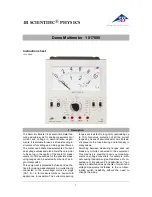
5.5 Diode test
Never measure a diode when voltage is ap-
plied, and always measure it separately,
otherwise the measurement will be inaccu-
rate. For this purpose, it may be necessary
to solder the diode out of the circuit.
Set the selector switch (10) to the position
.
At the top of the display the symbol
for diode
test will appear. When the probe tips are ap-
plied to the diode in forward direction, the for-
ward voltage up to 0.999 V will be indicated.
The positive pole of the measuring current (ap-
prox. 0.3 mA) is applied to the red probe tip.
With an indication of approx. 0 V, the diode
has a short circuit. If “
OL
.” is indicated, the
diode has a higher forward voltage than 1 V
(e. g. LEDs), the diode is interrupted, con-
nected in reverse direction (reverse the polarity
of the diode), or has no contact to the probe
tips.
5.6 Capacitance measurement
The DMT-4004 allows to measure capacitors
with a capacitance up to 200
µ
F.
Set the selector switch (10) to the position
CAP
and apply the probe tips to the capacitor. The
measuring process may require a few seconds
so that it will take a while until the correct value
is indicated. If the capacitance is higher than
200
µ
F, “
OL
.” will appear to indicate that the
measuring range has been exceeded.
5.7 Frequency measurement
This meter allows to measure frequencies up
to 10 MHz. The sensitivity is:
Set the selector switch (10) to the position
Hz%
. Apply the probe tips to the measuring
points and read the frequency on the display.
In the AC voltage range and in the alternat -
ing current ranges, a frequency measurement
is also possible (
chapters 5.1 and 5.2).
5.8 Duty cycle measurement
The meter allows to measure the duty cycle
in %. The duty cycle is the ratio of the positive
signal part to the period, e. g.:
Measuring range: . . 0.1 % to 99.9 %
Sensitivity: . . . . . . . < 0.5 V~
Frequency range: . 5 Hz – 150 kHz
The positive signal part must be 100
µ
s –
100 ms.
1) Set the selector switch to the position
Hz%
.
The frequency measurement is activated.
2) Use the button Hz% (2) to switch over to
duty cycle measurement. On the right of the
display, the indication will change from “Hz”
to “%”.
3) Apply the probe tips to the measuring points
and read the duty cycle on the display.
4) To return to frequency measurement, press
the button Hz% once again.
In the AC voltage range and in the alternating
current ranges, a duty cycle measurement is
also possible (
chapters 5.1 and 5.2).
Frequency
Sensitivity
≤ 1 MHz
< 0.5 V~
> 1 MHz
> 3 V~
WARNING
Never measure a capacitor
when it is charged or when the
operating voltage is applied, oth-
erwise you will risk an electric
shock. Furthermore, the meas-
urement will be inaccurate.
Switch off the power supply and discharge
the capacitor before soldering it out of the cir-
cuit.
16
GB
















































